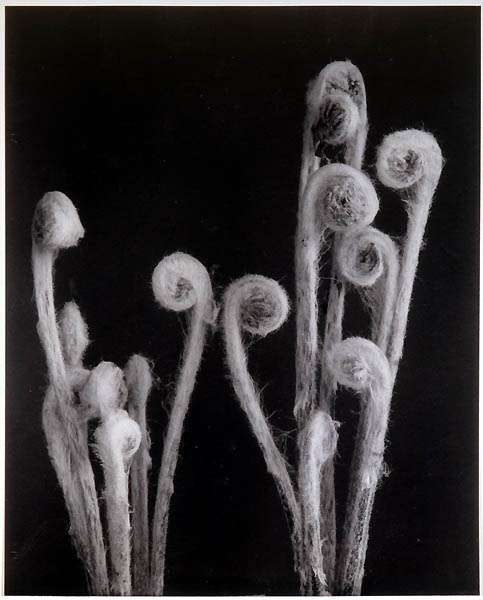Inventing Modernism – Edwin Hale Lincoln, Cinnamon Fern -American Museum of Photography
|
|
“Osmunda cinnamomea. Cinnamon Fern” Platinum print, 9.5 x 7.5 inches, 1904 |
Before his death at the age of 90 in 1938, Edwin Hale Lincoln produced thousands of exquisite platinum prints. Beginning in the 1890s, he concentrated on a series that would be published under the title The Wild Flowers of New England. This work, issued in various versions over the years, began as a compendium of 75 platinum prints in 1906. By 1914, each custom-produced set contained 400 images. (Karl Blossfeldt’s influential close-ups of plants would not be published in book form until 1928.)
At a time when atmospheric, soft-focus images were considered the pinnacle of creative photography, Lincoln stuck with sharpness and detail. But his compositions were often startlingly modern: plants might be shown in dramatic close-ups, as simple and elegant geometric patterns, or in carefully balanced lighting that causes the eye to shift from foreground to background and back again.
Although Lincoln was not affiliated with the Photo-Secession, his work was championed by Gustav Stickley, a leader of the American Arts & Crafts movement. “Cinnamon Fern” was included in a portfolio of Lincoln’s flower studies that appeared in Stickley’s elegant magazine, The Craftsman, in March of 1915. It was captioned: “The fiddleheads wrapped in their warm mantle of flower wool are the first to venture above the winter ground; their decorative quality is never seen to better advantage than in the photograph at the right, taken especially to bring out this quality.” In the Arts & Crafts aesthetic, “decorative” was high praise, especially when paired with a practical purpose — in the case of Lincoln’s flower studies, to inspire conservation. Gustav Stickley wrote in 1901, “…we may claim that artistic creations often attain a double end. They are useful and, at the same time, they afford keen sensuous pleasure.”
[Two more examples of Lincoln’s flower studies are included in our Masterworks of Photography exhibition: “Roses” and “Fruit of Common Milkweed” . Click on the titles to view the photographs in new browser windows.]
Copyright © MMVIII The American Photography Museum, Inc. All Rights Reserved.“American Museum of Photography” and the logo are Service Marks of The American Photography Museum, Inc.
